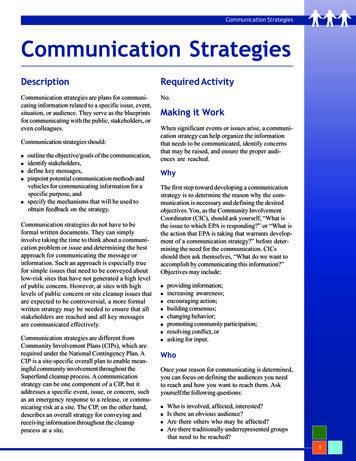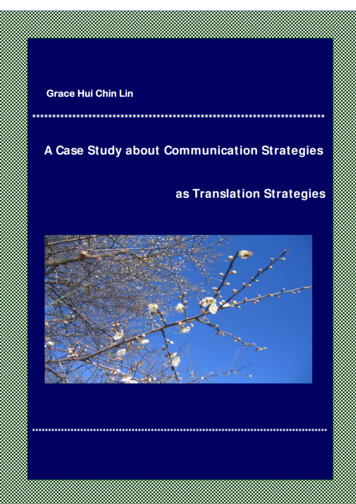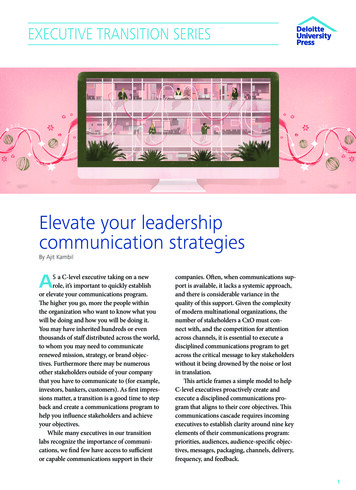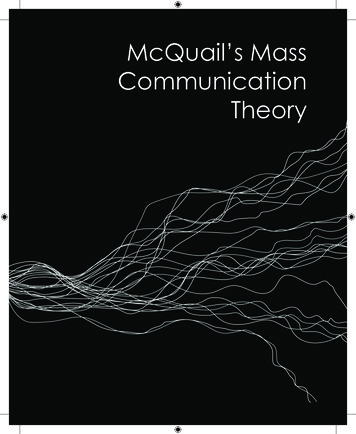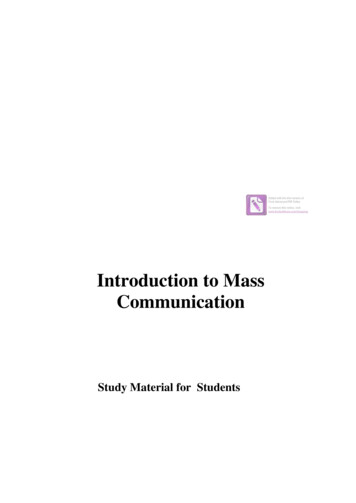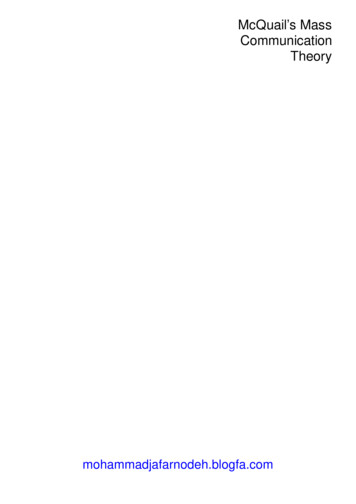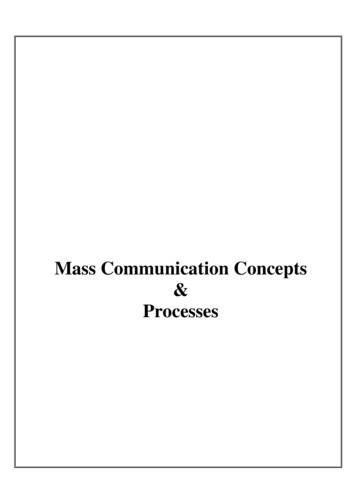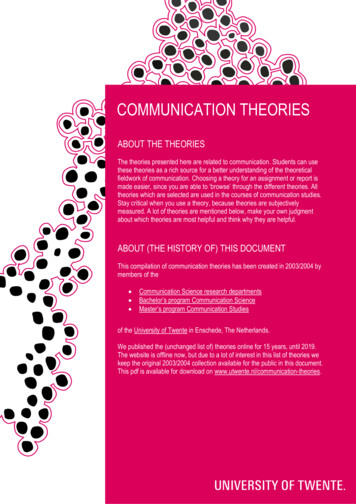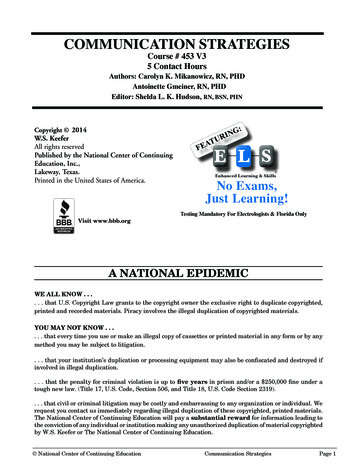
Transcription
COMMUNICATION STRATEGIESCourse # 453 V35 Contact HoursAuthors: Carolyn K. Mikanowicz, RN, PHDAntoinette Gmeiner, RN, PHDEditor: Shelda L. K. Hudson, RN, BSN, PHN:GRINCopyright 2014W.S. KeeferAll rights reservedPublished by the National Center of ContinuingEducation, Inc.,Lakeway, Texas.Printed in the United States of America.Visit www.bbb.orgUATFEE L S Enhanced Learning & SkillsNo Exams,Just Learning!Testing Mandatory For Electrologists & Florida OnlyA NATIONAL EPIDEMICWE ALL KNOW . . . . . that U.S. Copyright Law grants to the copyright owner the exclusive right to duplicate copyrighted,printed and recorded materials. Piracy involves the illegal duplication of copyrighted materials.YOU MAY NOT KNOW . . . . . that every time you use or make an illegal copy of cassettes or printed material in any form or by anymethod you may be subject to litigation. . . that your institution’s duplication or processing equipment may also be confiscated and destroyed ifinvolved in illegal duplication. . . that the penalty for criminal violation is up to five years in prison and/or a 250,000 fine under atough new law. (Title 17, U.S. Code, Section 506, and Title 18, U.S. Code Section 2319). . . that civil or criminal litigation may be costly and embarrassing to any organization or individual. Werequest you contact us immediately regarding illegal duplication of these copyrighted, printed materials.The National Center of Continuing Education will pay a substantial reward for information leading tothe conviction of any individual or institution making any unauthorized duplication of material copyrightedby W.S. Keefer or The National Center of Continuing Education. National Center of Continuing EducationCommunication StrategiesPage 1
TABLE OF CONTENTSAbout the Authors.3Purpose and Goals.3Instructional Objectives.3Introduction.3Definition of Communication.3Human Communication Types.4The Process of Human Communication.4Influencing Variables.4Perception .4Values.4Culture.5Gender Differences.5World-View.5Functional Elements .6Transactional.6Multidimensional.6Selected Models .6Shannon-Weaver Model.6SMCR Model.7Speech Communication Model.7Leary Model.7Symbolic Interactionist Model .7Communication Techniques.8Effective Speaking.8Effective Listening.9Feedback.9Alert to Nonverbal Signals.9Assertiveness.10Handling Conflict.10Personal Power.11The Power of Words.11Types of Communication.11Nonverbal Communication.11Verbal Communication.12Attitudes.12Therapeutic Techniques.13Obstacles in Communication.15Professional-Professional Relationships.16Role Stress.16Lack of Inter-Professional Understanding.16Role of Collaboration.16Collaborative Strategies.16Summary.17Suggested Reading.17Extraordinary effortshave been made by theauthors, the editor andthe publisher of the National Center of Continuing Education, Inc.courses to ensure dosage recommendations and treatments areprecise and agree with the higheststandards of practice. However, asa result of accumulating clinicalexperience and continuing laboratory studies, dosage schedules and/or treatment recommendationsare often altered or discontinued.This is most likely to occur withnewly introduced products or asa result of new research findings.We urge you to check the packageinformation of all medications andcomply with the manufacturer’srecom mended dosage. In all casesthe advice of a physician shouldbe sought and followed concerning initiating or discontinuing allmedications or treatments. Theauthors, editor and publisherdisclaim any responsibility forany adverse effects resulting fromthe information contained in thiscourse material. No part of thispublication may be reproduced,stored in a retrieval system ortransmitted in any form or by anymeans, electronic, mechanical,photocopying, recording or otherwise without the prior writtenpermission of the publisher.Course Material Valid through: 03/2015Page 2Communication Strategies National Center of Continuing Education
About the AuthorsIntroductionDr. Carolyn Mikanowicz, RN, PhDis an Associate Professor in the HealthProfessions Department and ProgramDirector for the Master in Health andHuman Services at Youngstown StateUniversity. She is a registered nurseand family planning nurse practitionerregistered in Pennsylvania.Antoinette Gmeiner, R.N. Ph.D.completed her Ph.D. at the Rand Afrikaans University in South Africa. Shehas varied experience in the field ofpsychiatric mental health nursing — asadvanced practitioner in private practice, as consultant in the field of mental health and as lecturer in psychiatricmental health nursing. Currently is senior lecturer at Rand Afrikaans University, Auckland Park, South Africaand responsible for the under-graduateprograms in psychiatric mental healthnursing.As long as people have wonderedabout the world, they have been intrigued by the mysteries of human nature. The most commonplace activitiesof our lives—the things we take forgranted—can become puzzling whenwe try to understand them systematically. Communication is an everydayactivity that is intertwined with allof human life so completely that wesometimes overlook its pervasiveness,importance, and complexity. Everyaspect of our daily lives is affected byour communication with others, as wellas by messages from people we don’teven know—people near and far. Thiscourse is designed to help you betterunderstand communication in all of itsaspects—its complexities, its powers,its possibilities, and its limitations.Theories of communication provideexplanations that help us understandthe phenomenon we call communication. By developing an understandingof a variety of communication theories,you can be more discriminating in yourinterpretation of communication andgain tools to improve your communication. Studying communication theorywill help you to see things you neversaw before, to see the unfamiliar in theeveryday. This widening of perception,or unhitching of blinders, will enableyou to go beyond habitual thinking andto become increasingly adaptable, flexible, and sophisticated in terms of yourapproach to communication. The wordcommunication is derived from theLatin “communico’, from “communis”or the word “common”. It means toshare, to impart, to take part in, to join,to unite or to connect. Communication,therefore, is a special process seen asa dynamic social interaction involving exchange of ideas between two ormore people. It is also to express feelings and probably the most significantof all human behaviors. It is said thatall behavior is communication and allcommunication affects behavior.Communication is a system of operations that includes language, gesturesor symbols to convey intended meaningand sharing of experience. Communication is the process of creating meaning between people.Communication is the foundation ofall interpersonal relationships and ourPurpose and GoalsThe goal of this course is to providehealth care professionals with a comprehensive overview of communicationstrategies that will assist in their dailywork and personal environments. Various types and models of communication are discussed as well as practicalstrategies for improving interpersonalrelationships.Instructional Objectives1. Define communication andlist the basic types of humancommunication.2. List the various models ofcommunication.3. Enumerate the variables thatinfluence communication.4. Name sources of conflictbetween healthcare professionals.5. List components and strategiesinvolved in professionalprofessional relationships.6. Define personal power7. Outline the role that gender playsin styles of communication.8. Compare and contrast differenttechniques of communication.9. Differentiate between verbaland non-verbal communicationtechniques. National Center of Continuing Educationdaily lives are filled with one communication experience after another. Thepurpose is twofold: the giving and receiving of information; and the makingof contact between people. If there isno communication there can be no relationship, therefore some will say thatcommunication is not only a behavior,it is the relationship.Therapeutic communication utilizedin the healthcare professions is facilitative in nature, focusing on a specificgoal. The message conveys a presenting problem, learning of more effectivecoping mechanisms and the development of ego-strengths. The core of thisis meaningful reaction of the nurse.Clients use communication toshare their ideas and feelings, expressthoughts and convey their life stories toco-construct new meanings. Throughthe contact between health professionaland client, new meanings (stories) areco-constructed and clients learn moreeffective ways of communicating withothers. Through communication, wereach some understanding of each other, learn to like, influence and trust eachother, begin and terminate relationships, and learn more about ourselvesand how others perceive us.Definition ofCommunicationCommunication is a key tool thathealth care professionals must use toelicit cooperation among individuals inthe delivery of health care services. Itis an integral part of socialization andimperative in establishing relationships. In the medical community, it canbe described as a process for sharinginformation through utilization of a setof common rules. These rules vary withcircumstances: for instance, the transfer of information can be interruptedby situational pressure; differences between the professionals’ perspectivescan interfere with shared meanings; andthe rules of the process of communication can be changed with inappropriateresponses.Communication among health professionals can:1. increase awareness of a healthissue, problem, or solution2. affect attitudes to create supportfor individual or collective actionCommunication StrategiesPage 3
3. demonstrate or illustrate skills4. increase demand for healthservices5. inform or reinforce knowledge,attitudes, or behaviorWith the disciplines of medicine andnursing working in close proximity,communication is not just practicingtogether, but individually interacting toachieve a common good: the health andwell-being of patients.Human communication is a subset ofcommunication. It refers to the interaction between people through the use ofsymbolic language. For example, it canbe an ongoing dialogue about a patientconcern, behavior, attitude, or diagnosis. It reflects how medical professionals seek to maintain health and dealwith health-related issues. These transactions that occur among health professionals can be verbal or nonverbal, oralor written, personal or impersonal, andissue oriented or relationship oriented.Human CommunicationTypesAmong the different kinds of humancommunication are: intrapersonal communication interpersonal communication small group communication organizational communication public communication mass communicationIntrapersonal communication refersto inner thoughts, beliefs, and feelings,and inner talk about health issues thatinfluence the individual’s health-directed behaviors.In the interpersonal context, communication includes those variablesthat directly affect professional — professional and professional — clientinteraction.Within the small group context, communication includes treatment planningmeetings, staff reports, and health teaminteractions.In organizational communicationareas listed are hospital administration, staff relations, and organizationalcommunication.Public communication refers to presentations, speeches, and public addresses made by individuals on healthrelated topics.Finally, mass communication pointsPage 4Communication Strategiesto areas such as national and worldhealth programs, health promotion, andpublic health planning.Influencing VariablesThe Process of HumanCommunicationPerception is a process whereby eachindividual selects, organizes, and interprets images of the world around him.Each individual also has a differentperception about things in the worldand how they view the world related toneeds, values, beliefs, and culture. Thismakes perception a highly personaland internal process. What individuals perceive depends on understandingpast experiences. Past experiences
communication. 3. Enumerate the variables that influence communication. 4. Name sources of conflict between healthcare professionals. 5. List components and strategies involved in professional-professional relationships. 6. Define personal power 7. Outline the role that gender plays in styles of communication. 8. Compare and contrast different techniques of communication. 9. Differentiate

